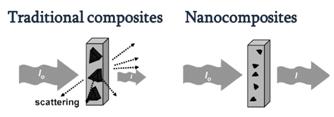Synthesis and characterization of novel polymeric nanostructures
Nanostructured polymer materials have attracted growing interest due their applicability in many different areas: from microelectronics to photonics, from catalysis to water purification, from biomedical to military applications. Among many different strategies used for preparing polymeric nanostructures, we focus our research on self-organization of block copolymers and dispersion of inorganic nanoparticles in polymer matrices.
New materials based on block copolymers

Block copolymers are constituted by two or three different types of polymer chains connected at the ends with a covalent bond. They display self-organization on the nanometre scale modulated by the external environment. For example, the interaction between block copolymer and solvent produces a diversity of self assembled shapes, including vescicles, spheres, cylinders, that can be tuned by concentration, solvent polarity, temperature and other external stimuli. The morphology in the solid state can also be very complex and is finely tuned by the conditions and the method of solid formation (melt cooling, casting from solvent).
Recently, by implementing advanced polymerization techniques like RAFT (Reversible Addition-Fragmentation chain Transfer polymerization) we synthesized several samples of highly controlled amphiphilic block copolymers. Our interest is currently focused on innovative techniques for their characterization in liquid and solid state, as well as the almost unexplored intermediate soft matter states: highly concentrated solutions, gels and sponge-like materials.
Nanoparticle polymer nanocomposites

The mixing of polymers and inorganic nanoparticles, like oxides, semiconductors (usually defined as quantum dots) or noble metals, is opening pathways for engineering flexible composites that exhibit advantageous electrical, optical, or mechanical properties. In particular, the nanocomposite optical characteristics, as the refractive index, absorption of UV light, birefringence or scattering properties, can be modulated by carefully choosing the particle size and electronic structure of the nanoparticle used for its preparation.
Our research is now directed to the use of oxide nanoparticles with all the dimensions less than 100 nm. A key point of the experimental activity is the surface modification of the nanoparticles by a capping agent in order to increase the stability of the colloidal dispersion.
Nanocomposite molecular structure, morphology and mechanical properties are characterized by a comprehensive suite of advanced techniques, (among others: FTIR, TGA, NMR, DLS, AFM). The measurement of optical properties (absorption, transmission, angular scattering) of nanocomposite monolithic objects is done in collaboration with the group of Prof. P. Di Trapani at the University of Insubria. Another possible application of these nanocomposites is in the conservation of cultural heritage, as protective layer that can protect the painting surface from UV radiation, preserving the aesthetics.
Research Group
Prof. Roberto Simonutti
Dr. Michele Mauri
Research Lab
U5 Building, Ground Floor, Room T068-T070B